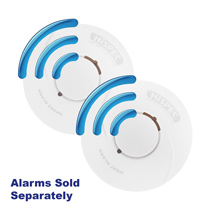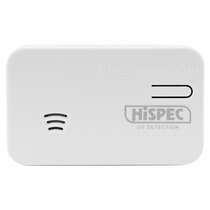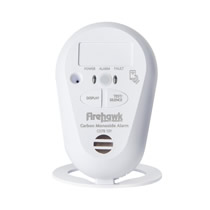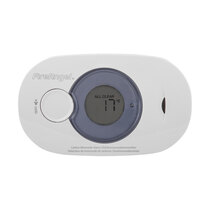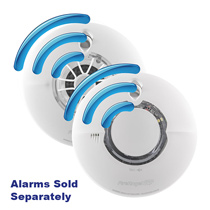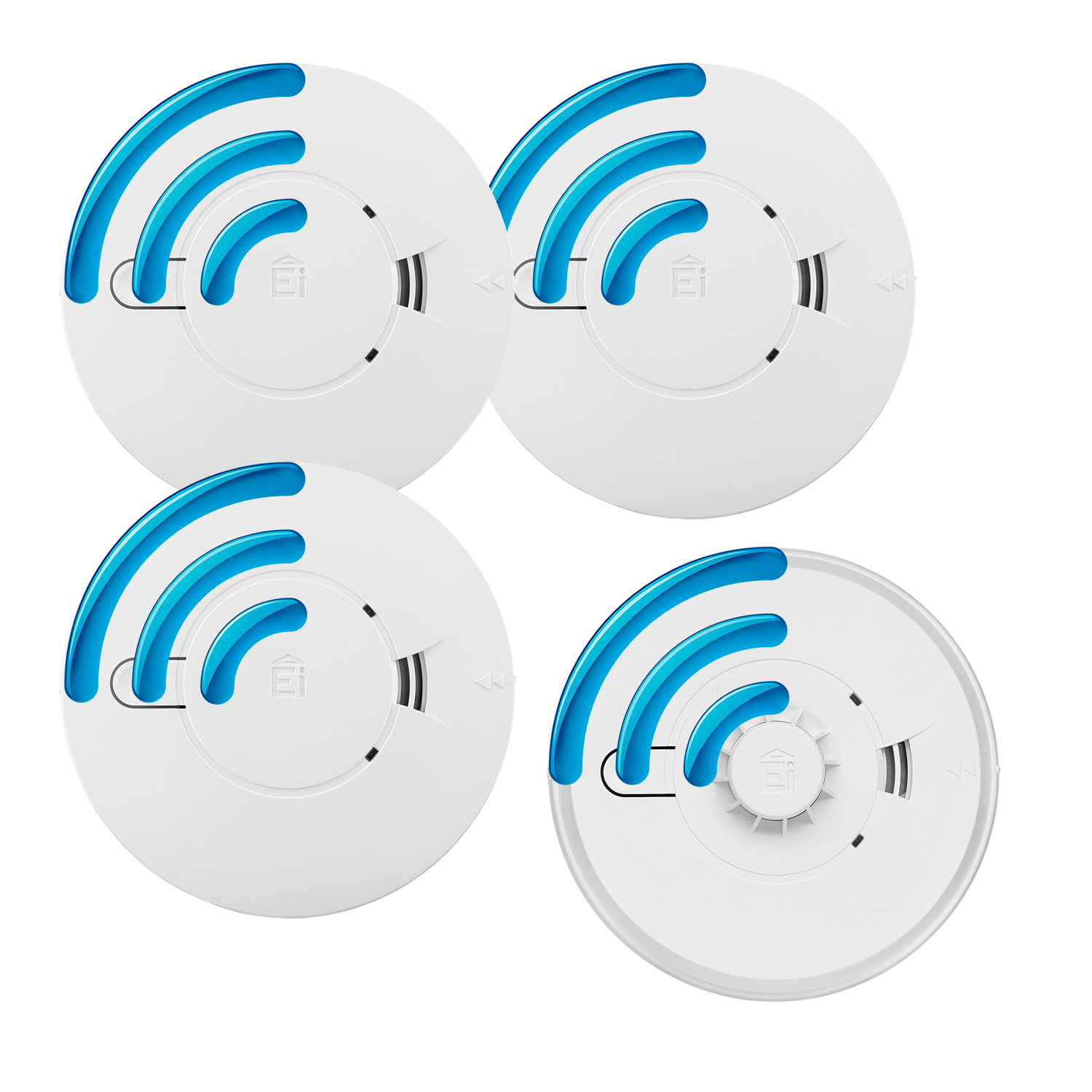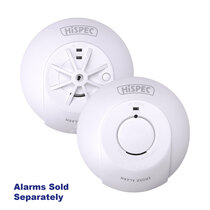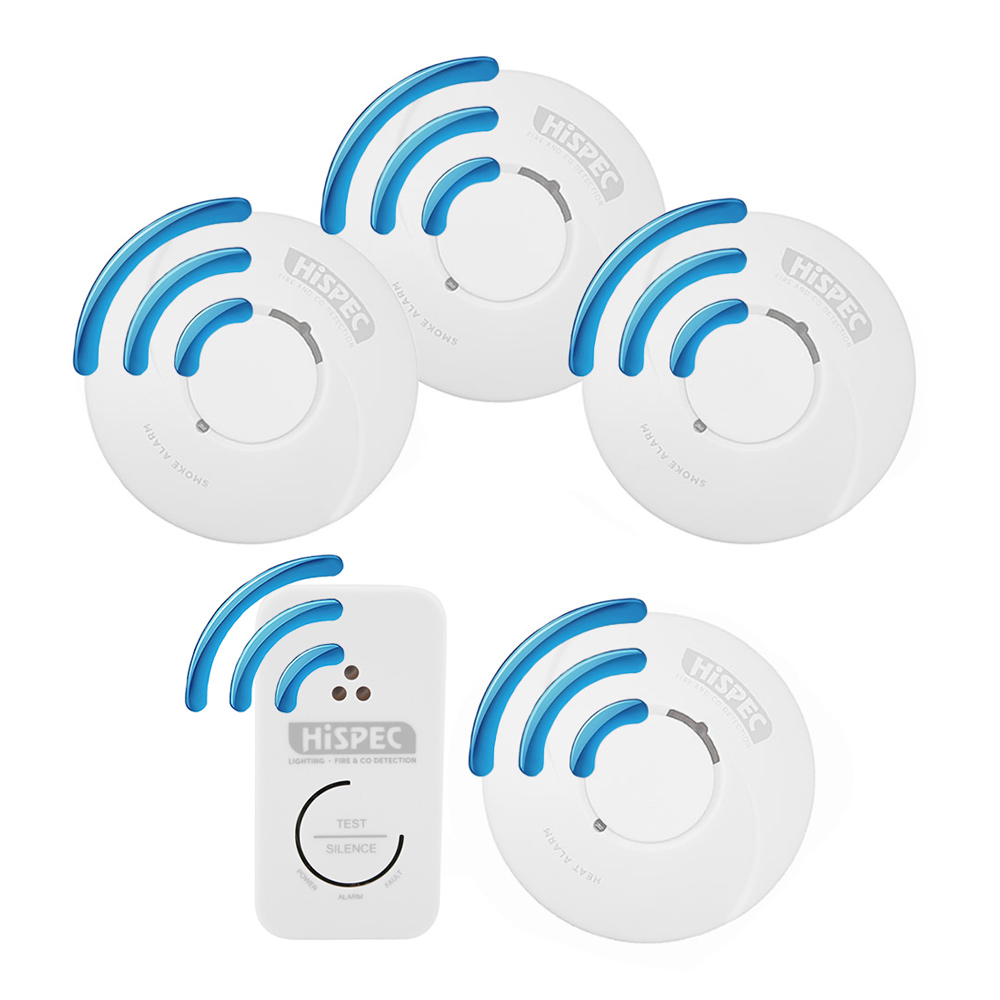-
Contact
Sales & Customer Service
0800 612 6537 support@safelincs.co.uk Live ChatDelivery Enquiries
0800 077 6149 - Resources
Fire & Safety Solutions
CALL OUR TEAM NOW 0800 612 6537
Lines open today 8am - 6pm
FREE Delivery
on marked products
Live Chat - Online
Instant help & Advice
Trade Discounts
and exclusive pricing
0% Credit Available
Open an account now
5 Star Customer Feedback
Alarms Suitable for Northern Ireland Landlord Regulations
From September 2024 all rented homes in Northern Ireland must be fitted with interlinking smoke and heat alarms. In addition, carbon monoxide alarms are required if there is a fixed combustion appliance or a flue (this also includes any rooms that a flue passes through). Every alarm in this section has been selected to comply with the new legislation.
Power supply: All alarms must be powered by a sealed battery, lasting the full lifespan of the alarm, or from the properties mains electrical circuit.
Interlink: All smoke and heat alarms, within one property, must either interlink with one another by hardwire cable or by a wireless radio-frequency interlink. However, carbon monoxide alarms do not have to interlink with the installed smoke and heat alarms.
10 Year Longlife Battery Carbon Monoxide Detector - UltraFire ULLCO10
- Product Lifespan: 10 years
- Battery: Sealed-in Lithium Battery
- Warranty: 10 year warranty
- Coloured LEDs to indicate alarm, power, and fault
- Kitemarked to BS EN50291-1 (domestic use)
- Kitemarked to BS EN50291-2 (caravans / boats)
- Compliant with Scottish 2022, Welsh Landlord 2022, and Northern Ireland Landlord 2024 legislation
- Suitable for new fuel-burning appliances per Building Regs Document J
Travel Longlife Battery Carbon Monoxide Detector – UltraFire ULLCO10 with Strap
- Product Lifespan: 10 years
- Battery: Sealed-in Lithium Battery
- Warranty: 10-year warranty
- Kitemarked to BS EN 50291-1 (domestic use)
- Kitemarked to BS EN 50291-2 (caravans / boats)
- Ideal for travellers and backpackers
- Supplied with a travel strap
Write a review
View Product
| 1 unit |
£21.77 inc VAT £18.14 ex VAT |
|---|---|
| 2+ units |
£21.17 inc VAT £17.64 ex VAT |
| 5+ units |
£20.87 inc VAT £17.39 ex VAT |
Mains Powered 3 Smoke Alarms and 1 Heat Alarm Kit with Self-Charging 10 Year Back-up Battery - Kidde Firex KF-R Series
- Power: 230V mains powered with self-charging lithium back-up battery
- Back-up Battery: Self-charging 10 year back-up battery
- Warranty: 6 year warranty
- Hardwire interlink up to 24 compatible devices
- Suitable for BS 5839-6: 2019 Grade D1 installations
- Compliant with Scottish 2022, Welsh Landlord 2022, and Northern Ireland Landlord 2024 legislation
Mains Powered 2 Smoke Alarms and 1 Heat Alarm Kit with Self-Charging 10 Year Back-up Battery - Kidde Firex KF-R Series
- Power: 230V mains powered with self-charging lithium back-up battery
- Back-up Battery: Self-charging 10 year back-up battery
- Warranty: 6 year warranty
- Hardwire interlink up to 24 compatible devices
- Suitable for BS 5839-6: 2019 Grade D1 installations
- Compliant with Scottish 2022, Welsh Landlord 2022, and Northern Ireland Landlord 2024 legislation
10 Year Longlife Battery Carbon Monoxide Alarm with Digital Display - Kidde K10LLDCO
- Product Lifespan: 10 years
- Battery: Sealed-in lithium battery
- Warranty: 10 year warranty
- Digital display of CO levels from 11ppm
- Kitemarked to BS EN 50291-1: 2018 for home use
- Compliant with Scottish 2022, Welsh Landlord 2022, and Northern Ireland Landlord 2024 legislation
Radio-Interlinked Sealed Battery Powered Smoke & Heat Alarms - Hispec RF10-PRO Range
- Battery: 10 year sealed lithium battery
- Warranty: 5 year warranty
- Radio-interlink up to 20 Hispec RF10-PRO Alarms
- Suitable for BS 5839-6: 2019 Grade F1 installations
- Compatible with the Hispec Control Unit and Carbon Monoxide Alarm
- Alarms sold separately
- Compliant with Scottish 2022 and Northern Ireland Landlord 2024 legislation
10 Year Longlife Battery Carbon Monoxide Detector - Hispec HSA/BC/10
- Product Lifespan: 10 years
- Battery: 10 year sealed lithium battery
- Warranty: 5 year warranty
- Suitable for free standing or wall mounting
- Certified to BS EN 50291-1 for home use
- Compliant with Scottish 2022, Welsh Landlord 2022, and Northern Ireland Landlord 2024 legislation
Mains Powered 3 Smoke Alarms and 1 Heat Alarm Kit with Alkaline Back-up Battery - Aico Ei140e Series
- Power: 230V mains powered with alkaline back-up battery
- Warranty: 5 year warranty
- 3 x optical smoke alarms and 1 x heat alarm included in the kit
- Central test and hush buttons
- Hardwire interlink with up to 12 devices
- Suitable for BS 5839-6: 2019 Grade D2 installations
- Compliant with Scottish 2022, Welsh Landlord 2022, and Northern Ireland Landlord 2024 legislation
Mains Powered 2 Smoke Alarms and 1 Heat Alarm Kit with Alkaline Back-up Battery - Aico Ei140e Series
- Power: 230V mains powered with alkaline back-up battery
- Warranty: 5 year warranty
- 2 x optical smoke alarms and 1 x heat alarm included
- Test and hush buttons
- Hardwire interlink with up to 12 devices
- Suitable for BS 5839-6: 2019 Grade D2 installations
- Compliant with Scottish 2022, Welsh Landlord 2022, and Northern Ireland Landlord 2024 legislation
Mains Powered 3 Smoke Alarms and 1 Heat Alarm Kit with Alkaline Back-up Batteries - Firehawk
- Power: 230V mains powered with alkaline back-up battery
- Back-up Battery: 3 x AAA alkaline batteries (included)
- Warranty: 6 year manufacturer's warranty
- Hardwire interlink with up to 12 Firehawk FHN devices in total
- Suitable for BS 5839-6: 2019 Grade D2 installations
- Compliant with Scottish 2022, Welsh Landlord 2022, and Northern Ireland Landlord 2024 legislation
Mains Powered 2 Smoke Alarms and 1 Heat Alarm Kit with Alkaline Back-up Batteries - Firehawk
- Power: 230V mains powered with alkaline back-up battery
- Back-up Battery: 3 x AAA alkaline batteries (included)
- Warranty: 6 year manufacturer's warranty
- Hardwire interlink with up to 12 Firehawk FHN devices in total
- Suitable for BS 5839-6: 2019 Grade D2 installations
- Compliant with Scottish 2022, Welsh Landlord 2022, and Northern Ireland Landlord 2024 legislation
10 Year Longlife Battery LED Carbon Monoxide Alarm - Firehawk CO7B-10Y
- Product Life: 10 years
- Battery: Longlife lithium battery
- Warranty: 10 year warranty
- Ideal for domestic use and camping, caravans, and boats
- Kitemarked to BS EN 50291-1 and BS EN 50291-2
- Compliant with Scottish 2022, Welsh Landlord 2022, and Northern Ireland Landlord 2024 legislation
Mains Powered Smoke Alarms & Heat Alarms with Alkaline Back-up Battery - FireAngel W1-R Series
- Power: 230V mains powered with battery back-up
- Backup Battery: 9V alkaline battery (included)
- Warranty: 1 year warranty
- Available in Optical and Heat versions
- Interlinks with up to 12 units
- Kitemarked, CE marked and suitable for BS 5839-6: 2019 Grade D2
- Please note: alarms are sold individually
- Compliant with Scottish 2022, Welsh Landlord 2022, and Northern Ireland Landlord 2024 legislation
10 Year Longlife Battery Carbon Monoxide Alarm with Digital Display - FireAngel FA3322
- Product Lifespan: 10 years
- Battery: 10 year sealed lithium battery
- Warranty: 5 year warranty
- Sleep Easy™ and Night Time Sensing eliminate midnight battery warnings
- Digital display shows CO levels, modes, warning conditions, and temperature
- Ideal for home use and camping / caravans / boats
- Kitemarked to BS EN50291-1:2018 and BS EN50291-2:2019
- Compliant with Scottish 2022, Welsh Landlord 2022, and Northern Ireland Landlord 2024 legislation
- Suitable for new fuel-burning appliances per Building Regs Document J
10 Year Longlife Battery Radio-Interlinked Smoke Alarms and Heat Alarms - FireAngel Pro Connected Series
- Battery operated – 10 year sealed lithium battery
- Available in Optical and Heat versions (FP2620W2-R and FP1720W2-R)
- Interlinks via radio frequency with up to 50 units
- Kitemarked, CE marked and suitable for BS 5839-6: 2019 Grade F1 installations
- Compatible with the FireAngel Pro Connected Gateway
- Please note: alarms are sold individually
- Compliant with Scottish 2022 and Northern Ireland Landlord 2024 legislation
10 Year Longlife Battery Radio-Interlinked Carbon Monoxide Alarm - FireAngel Pro Connected FP1820W2-R
- Product Lifespan: 10 years
- Battery: Built-in, lasts the lifetime of your alarm
- Warranty: 1 year warranty
- Can interlink with any Wi-Safe 2 compatible device
- Suitable for free standing or wall mounting
- Kitemarked to BS EN 50291-1 (domestic use)
- Kitemarked to BS EN 50291-2 (camping / caravans / boats)
- Compliant with Scottish 2022, Welsh Landlord 2022, and Northern Ireland Landlord 2024 legislation
Mains Powered Radio-Interlink 3 Smoke Alarms and 1 Heat Alarm Kit with Alkaline Back-up Battery - Aico Ei140eRF Series
- Power: 230V mains powered with alkaline back-up battery
- Back-up Battery: 9V alkaline battery (included)
- Warranty: 5 year warranty
- Radio-interlink with up to 12 compatible devices
- Suitable for BS 5839-6: 2019 Grade D2 installations
- Compliant with Scottish 2022, Welsh Landlord 2022, and Northern Ireland Landlord 2024 legislation
Mains Powered Radio-Interlink 2 Smoke Alarms and 1 Heat Alarm Kit with Alkaline Back-up Battery - Aico Ei140eRF Series
- Power: 230V mains powered with alkaline back-up battery
- Back-up Battery: 9V alkaline battery (included)
- Warranty: 5 year warranty
- Radio-interlink with up to 12 compatible devices
- Suitable for BS 5839-6: 2019 Grade D2 installations
- Compliant with Scottish 2022, Welsh Landlord 2022, and Northern Ireland Landlord 2024 legislation
Mains Powered Radio-Interlink Smoke & Heat Alarms with Lithium Back-Up Battery - Hispec RF10-PRO
These mains-powered alarms from Hispec feature RF10-PRO wireless interlink for whole-house coverage, with a sealed rechargeable lithium back-up battery and 5-year manufacturer's warranty.
- Optical Smoke and Heat sensor types available
- Wireless interlink up to 20 RF10-PRO devices
- Test & Hush feature, compatible with Hispec Remote Control
- Compliant with Scottish 2022, Welsh Landlord 2022, and Northern Ireland Landlord 2024 legislation
Radio-Interlinked Sealed Battery 3 Smoke, 1 Heat, and 1 CO Alarm Kit - Hispec RF10-Pro Range
- Battery: 10 year sealed lithium battery
- Warranty: 5 year warranty
- Radio-interlink up to 20 Hispec RF10-Pro Alarms
- Suitable for BS 5839-6: 2019 Grade F1 installations
- Compatible with the Hispec Control Unit
- Also suitable for the 2022 Scottish legislation
Page 1 (20 of 24 Products)
2024 Northern Ireland Landlord Legislation
Alarm Power Requirements
Interlink Compatibility
2024 Northern Ireland Landlord Legislation
In effect from September 2024, Northern Ireland updated legislation covering fire alarms in rented properties. The new requirements for landlords in Northern Ireland, applies to all rented accommodation and cover smoke, heat, and carbon monoxide alarms, as appropriate. A general summary of the new requirements are:
- One smoke alarm in the room most frequently used during the daytime.
- One smoke alarm in every circulation space on each storey (e.g. hallways and landings).
- One heat alarm in each kitchen.
- The smoke and heat alarms must be ceiling-mounted and interlinked.
- Where there is a fixed combustion appliance (e.g. boiler or gas cooker) or a flue (that will include any rooms where a flue passes through), a carbon monoxide alarm is also required.
- All types of alarm must be mains powered (fixed wiring, not a mains plug) OR powered by a tamper-proof lifetime battery.
- All alarms must be regularly maintained and tested in accordance with the manufacturer's instructions.
For smoke and heat alarms, it can be compared to compliance with Grades D1, D2, or F1 (which can interlink) from BS 5839-6: 2019 – see our full guide to BS 5839 Part 6 for more details on types of alarm.
Alarm Power Requirements
To comply with the updated Northern Ireland Landlord legislation, smoke and heat alarms must be Grade D2, D1, or F1. Battery-powered Grade F1 models can only be used if they support interlinking, so care must be taken to select suitable products as most Grade F1 alarms on the market are stand-alone models. Please see the table below for more details on the Grades of alarm.
Carbon monoxide alarms do not use the same Grade distinction as smoke and heat alarms, so you must simply pay attention to the manufacturer's information regarding power source. The power requirements for carbon monoxide alarms are the same as for smoke and heat alarms: either a tamper-proof battery that lasts the full lifespan of the product, or wired into a mains circuit in the property.
Any mains-powered alarms, regardless of sensor type, must be permanently wired into a mains circuit. Alarms which use a mains plug are not suitable for the updated regulations.
Smoke & Heat Alarm Grades
British Standard 5839 Part 6 is a code of practice relating to the design, installation and maintenance of fire detection systems in domestic premises. The standard also grades fire detection systems which reflects their functionality and capability. The below table details the up-to-date grades for fire detection systems.
Alarm Grades by Power Type (BS 5839 Part 6)
| BS 5839-6: 2019 Grade | Alarm Power Type | Grade Description |
|---|---|---|
| Grade F1 | Battery Operated (Lithium) | System of one or more battery-powered smoke alarms (and heat alarms if required). The battery must be tamper-proof and last the full life of the alarm. |
| Grade F2 | Battery Operated (Alkaline) | System of one or more battery-powered smoke alarms (and heat alarms if required). The battery is user-replaceable and will not last the full life of the alarm. |
| Grade D1 | Mains Powered (Lithium Back-up) | System incorporating one or more interlinked mains-powered smoke alarms (and heat alarms if required), each with an integral stand-by supply. They can be hardwire-interlinked or radio-interlinked. The stand-by supply must be tamper-proof and last the full life of the alarm. |
| Grade D2 | Mains Powered (Alkaline Back-up) | System incorporating one or more interlinked mains-powered smoke alarms (and heat alarms if required), each with an integral stand-by supply. They can be hardwire-interlinked or radio-interlinked. The stand-by supply is user-replaceable and will not last the full life of the alarm. |
| Grade C | Mains Powered (Dedicated Circuit + Back-up) | System consisting of fire detectors and alarm sounders (which may be domestic smoke alarms) connected to a common power supply, comprising normal mains and stand-by supply, with central control equipment. |
| Grade A | Mains Powered (Panel - Built-in PSU + Back-up) | Fire detection system incorporating control and indicating equipment to BS EN 54-2, power supply to BS EN 54-4, and installed to BS 5839 Part 1, with some very minor exceptions. |
For a full summary of BS 5839 Part 6, please visit 'Fire Detection and Fire Alarm Systems for Buildings'.
Interlink Compatibility
Hardwire Interlink
Smoke alarms, heat alarms, and carbon monoxide alarms powered from a mains circuit will usually also have an interlink or interconnect terminal next to the live and neutral wire terminals. If one alarm detects a fire or CO emergency it will pass the signal to the other units which will also sound an alarm throughout the property. This is particularly important for large buildings or if the bedroom is located far away from the kitchen. Outhouses and garages can also be connected into the radio-interlinked alarm system for added peace of mind.
Mains alarms can be connected to nearby lighting circuits for power, provided the light switch does not also turn off power to the alarm, but the interlink wire must be separate and not 'piggy-back' on a mains circuit as smoke, heat, and CO alarms are not designed to take 230V in their interlink terminal. If the property does not already have mains-powered alarms wired in, or if testing one of your existing alarms does not also cause the other alarms to sound, then an electrician will need to install a new interlink cable throughout the building.
Radio-Interlink
Radio-interlinked smoke alarms, heat alarms, and carbon monoxide alarms communicate with each other via radio frequency (RF). If one alarm detects a fire or CO emergency it will pass the signal to the other units which will also sound an alarm throughout the property. This is particularly important for large buildings or if the bedroom is located far away from the kitchen. Outhouses and garages can also be connected into the radio-interlinked alarm system for added peace of mind.
Radio-interlinked alarms are sometimes referred to as wireless alarms, although this can be confusing when dealing with radio-interlinked units wired into the mains power supply in a building. Radio-interlinked alarms can be battery powered or mains powered, and we even offer battery operated smoke alarms, heat alarms, and carbon monoxide alarms with radio-interlink that contain a sealed battery which lasts the full ten years of the alarm's life.
Compatibility
Only interlink alarms with alarms from the same model range and manufacturer. Alarms from different manufacturers are not compatible and attempting to interlink them could damage the alarms. If in doubt, check the instruction manual for the alarms before purchase – we provide PDF instruction manual downloads for the majority of smoke, heat, and CO alarms on our website.
Some ranges support mixing hardwired and radio-interlink alarms in the same network, which can reduce electrician costs and disruption. All alarms on each storey would be connected together via hardwire interlink, with one alarm on each storey also being connected to each other via RF signal. This could also save money on product costs, as mains-powered alarms without radio-interlink are usually the cheapest option for interlinking alarms. Please confirm before purchase if you require this functionality.

























